Physiological and Agronomic Mechanisms Involved in ‘Source–Sink’ Relationship in the High-Yield Population of Weak-Gluten Wheat
Abstract
1. Introduction
2. Materials and Methods
2.1. Experimental Site and Weather Conditions
2.1.1. Field Assay
2.1.2. Pot Assay
2.2. Experimental Assays
2.2.1. Field Experiment
2.2.2. Pot Experiment
2.3. Measurements of Agronomical and Physiological Characteristics
2.3.1. Yield and Yield Component
2.3.2. Tiller Dynamics, Leaf Area Index, and Dry Matter Accumulation
2.3.3. Leaf Layer Transmittance
2.3.4. Net Photosynthetic Rate
2.3.5. 15N Abundance by Organ
2.3.6. Sucrose Synthase
2.3.7. Sucrose Content
2.3.8. 13C Abundance in Mature Organs
2.4. Statistical Analyses
3. Results and Analysis
3.1. Yield and Yield Components
3.2. LAI
3.3. Dry Matter Accumulation
3.4. Canopy Light Transmittance
3.5. Net Photosynthetic Rate
3.6. Nitrogen Fertilizer Utilization Rate
3.7. Sucrose Synthase Activity and Sucrose Content
3.8. C Content and Distribution Rate
4. Discussion
4.1. ‘Sink’-Yield Performance between Medium-High and Low Yield Groups
4.2. ‘Source’-Photosynthetic Characteristics between Medium-High and Low Yield Groups
4.3. Carbon and Nitrogen Transport and Partitioning between Medium-High and Low Yield Group
5. Conclusions
Author Contributions
Funding
Institutional Review Board Statement
Informed Consent Statement
Data Availability Statement
Conflicts of Interest
References
- Govindan, V.; Ravi, P.S.; Julio, H.; Carlos, G. Genetic impact of Rht dwarfing genes on grain micronutrients concentration in wheat. Field Crop. Res. 2017, 214, 373–377. [Google Scholar]
- Jacques, L.G.; François-Xavier, O.; Gilles, C. How changes in climate and agricultural practices influenced wheat production in Western Europe. J. Cereal Sci. 2020, 93, 102960. [Google Scholar] [CrossRef]
- Qin, X.; Zhang, F.X.; Liu, C.; Yu, H.; Cao, B.G.; Tian, S.Q.; Liao, Y.C.; Siddique, K.H.M. Wheat yield improvements in China: Past trends and future directions. Field Crop. Res. 2015, 177, 117–124. [Google Scholar] [CrossRef]
- Moghimi, M.M.; Shamshiri, G.; Shabani, A.; Kamgar-Haghighi, A.A.; Fateh, M.; Mahmoudi, M.R. Determining optimum applied water and seeding rates for winter wheat by using Aqua Crop and mathematical-economic analysis. Irrig. Drain. 2022, 71, 349–364. [Google Scholar] [CrossRef]
- Guan, X.J.; Chen, J.; Chen, X.M.; Xie, J.; Deng, G.Q.; Hu, L.Z.; Li, Y.; Qian, Y.F.; Qiu, C.F.; Peng, C.R. Root characteristics and yield of rice as affected by the cultivation pattern of strong seedlings with increased planting density and reduced nitrogen application. J. Integr. Agric. 2022, 21, 1278–1289. [Google Scholar] [CrossRef]
- Arduini, A.; Masoni, L.; Ercoli, M.; Mariotti. Grain yield, and dry matter and nitrogen accumulation and remobilization in durum wheat as affected by variety and seeding rate. Eur. J. Agron. 2006, 25, 309–318. [Google Scholar] [CrossRef]
- Liu, T.N.; Wang, Z.L.; Cai, T. Canopy Apparent Photosynthetic Characteristics and Yield of Two Spike-Type Wheat Cultivars in Response to Row Spacing under High Plant Density. PLoS ONE 2016, 11, e0148582. [Google Scholar] [CrossRef]
- Zheng, B.Q.; Zhang, X.Q.; Wang, Q.; Li, W.Y.; Huang, M.; Zhou, Q.; Cai, J.; Wang, X.; Cao, W.X.; Dai, T.B.; et al. Increasing plant density improves grain yield, protein quality and nitrogen agronomic efficiency of soft wheat cultivars with reduced nitrogen rate. Field Crop. Res. 2021, 267, 108145. [Google Scholar] [CrossRef]
- Cai, T.; Xu, H.; Peng, D.L.; Yin, Y.P.; Yang, W.B.; Ni, Y.L.; Chen, X.G.; Xu, C.L.; Yang, D.Q.; Cui, Z.Y.; et al. Exogenous hormonal application improves grain yield of wheat by optimizing tiller productivity. Field Crop. Res. 2014, 155, 172–183. [Google Scholar] [CrossRef]
- Li, C.; Wang, X.S.; Guo, Z.K.; Huang, N.; Hou, S.B.; He, G.; William, D.B.; Kadambot, H.M.; Siddique; Wang, Z.H.; et al. Optimizing nitrogen fertilizer inputs and plant populations for greener wheat production with high yields and high efficiency in dryland areas. Field Crop. Res. 2022, 276, 108374. [Google Scholar] [CrossRef]
- Brestic, M.; Zivcak, M.; Hauptvogel, P.; Misheva, S.; Kocheva, K.; Yang, X.; Li, X.; Allakhverdiev, S.I. Wheat plant selection for high yields entailed improvement of leaf anatomical and biochemical traits including tolerance to non-optimal temperature conditions. Photosynth. Res. 2018, 136, 245–255. [Google Scholar] [CrossRef] [PubMed]
- Makino, A. Photosynthesis, grain yield, and nitrogen utilization in rice and wheat. Plant Physiol. 2011, 155, 125–129. [Google Scholar] [CrossRef] [PubMed]
- Zeeman, S.C.; Kossmann, J.; Smith, A.M. Starch: Its metabolism, evolution, and biotechnological modification in plants. Annu. Rev. Plant Biol. 2010, 61, 209–234. [Google Scholar] [CrossRef] [PubMed]
- Qu, J.; Xu, S.; Zhang, Z.; Chen, G.; Zhong, Y.; Liu, L.; Zhang, R.; Xue, J.; Guo, D. Evolutionary, structural and expression analysis of core genes involved in starch synthesis. Sci. Rep. 2018, 8, 12736. [Google Scholar] [CrossRef] [PubMed]
- Li, Y.Y.; Ming, B.; Fan, P.P.; Liu, Y.; Wang, K.R.; Hou, P.; Xue, J.; Li, S.K.; Xie, R.Z. Quantifying contributions of leaf area and longevity to leaf area duration under increased planting density and nitrogen input regimens during maize yield improvement. Field Crop. Res. 2022, 283, 108551. [Google Scholar] [CrossRef]
- Nerson, H. Effects of population density and number of ears on wheat yield and its components. Field Crop. Res. 1980, 3, 225–234. [Google Scholar] [CrossRef]
- Piazza, P.; Jasinski, S.; Tsiantis, M. Evolution of leaf developmental mechanisms. New Phytol. 2005, 167, 693–710. [Google Scholar] [CrossRef]
- Rowan, F.S.; Robert, W.P. The Nitrogen Use Efficiency of C3 and C4 Plants: II. Leaf Nitrogen Effects on the Gas Exchange Characteristics of Chenopodium album (L.) and Amaranthus retroflexus (L.). Plant Physiol. 1987, 84, 953–959. [Google Scholar]
- Richard, A.; Richards, C.R.; Cavanagh, P.R. Selection for erect canopy architecture can increase yield and biomass of spring wheat. Field Crop. Res. 2019, 244, 107649. [Google Scholar] [CrossRef]
- Du, X.; Gao, Z.; Sun, X.N.; Bian, D.H.; Ren, J.H.; Yan, P.; Cui, Y.H. Increasing temperature during early spring increases winter wheat grain yield by advancing phenology and mitigating leaf senescence. Sci. Total Environ. 2022, 812, 152557. [Google Scholar] [CrossRef]
- Yang, H.W.; Chai, Q.; Yin, W.; Hu, F.L.; Qin, A.Z.; Fan, Z.L.; Yu, A.Z.; Zhao, C.; Fan, H. Yield photosynthesis and leaf anatomy of maize in inter- and mono-cropping systems at varying plant densities. Crop J. 2021, 10, 839–930. [Google Scholar] [CrossRef]
- Antonietta, M.; Fanello, D.D.; Acciaresi, H.A.; Guiamet, J.J. Senescence and yield responses to plant density in stay green and earlier-senescing maize hybrids from Argentina. Field Crop. Res. 2014, 155, 111–119. [Google Scholar] [CrossRef]
- Manisha, K.; Bavita, A. Transformation of Sucrose to Starch and Protein in Rice Leaves and Grains under Two Establishment Methods. Rice Sci. 2016, 23, 255–265. [Google Scholar]
- Yang, J.C.; Zhang, J.H.; Wang, Z.Q.; Zhu, Q.S.; Liu, L.J. Activities of enzymes involved in sucrose-to-starch metabolism in rice grains subjected to water stress during filling. Field Crop. Res. 2003, 81, 69–81. [Google Scholar] [CrossRef]
- Huang, M.; Chen, J.N.; Cao, F.B.; Liu, Y.; Xiao, Z.W.; Hu, L.Q.; Chen, G.H.; Zou, Y.B. The activity ratio of glutamine synthetase to sucrose synthase: A physiological feature explaining the variation in grain nitrogen-based protein content of rice. J. Cereal Sci. 2020, 91, 102902. [Google Scholar] [CrossRef]
- Lambert, D.M.; Lowenberg-DeBoer, J.; Malzer, G.L. Economic Analysis of Spatial-Temporal Patterns in Corn and Soybean Response to Nitrogen and Phosphorus. Agro J. 2006, 98, 43–54. [Google Scholar] [CrossRef]
- Lassaletta, L.; Billen, G.; Grizzetti, B.; Anglade, J.; Garnier, J. 50 year trends in nitrogen use efficiency of world cropping systems: The relationship between yield and nitrogen input to cropland. Environ. Res. Lett. 2014, 9, 105011. [Google Scholar] [CrossRef]
- Christopher, J.S.; Phillip, M.C. The role of 15N in tracing N dynamics in agro-ecosystems under alternative systems of tillage management: A review. Soil Till Res. 2020, 197, 104496. [Google Scholar] [CrossRef]
- Luo, Z.; Hu, Q.Y.; Tang, W.; Wang, X.W.; Lu, H.Q.; Zhang, Z.; Liu, T.; Kong, X.Q. Effects of N fertilizer rate and planting density on short-season cotton yield, N agronomic efficiency and soil N using 15N tracing technique. Eur. J. Agron. 2022, 138, 126546. [Google Scholar] [CrossRef]
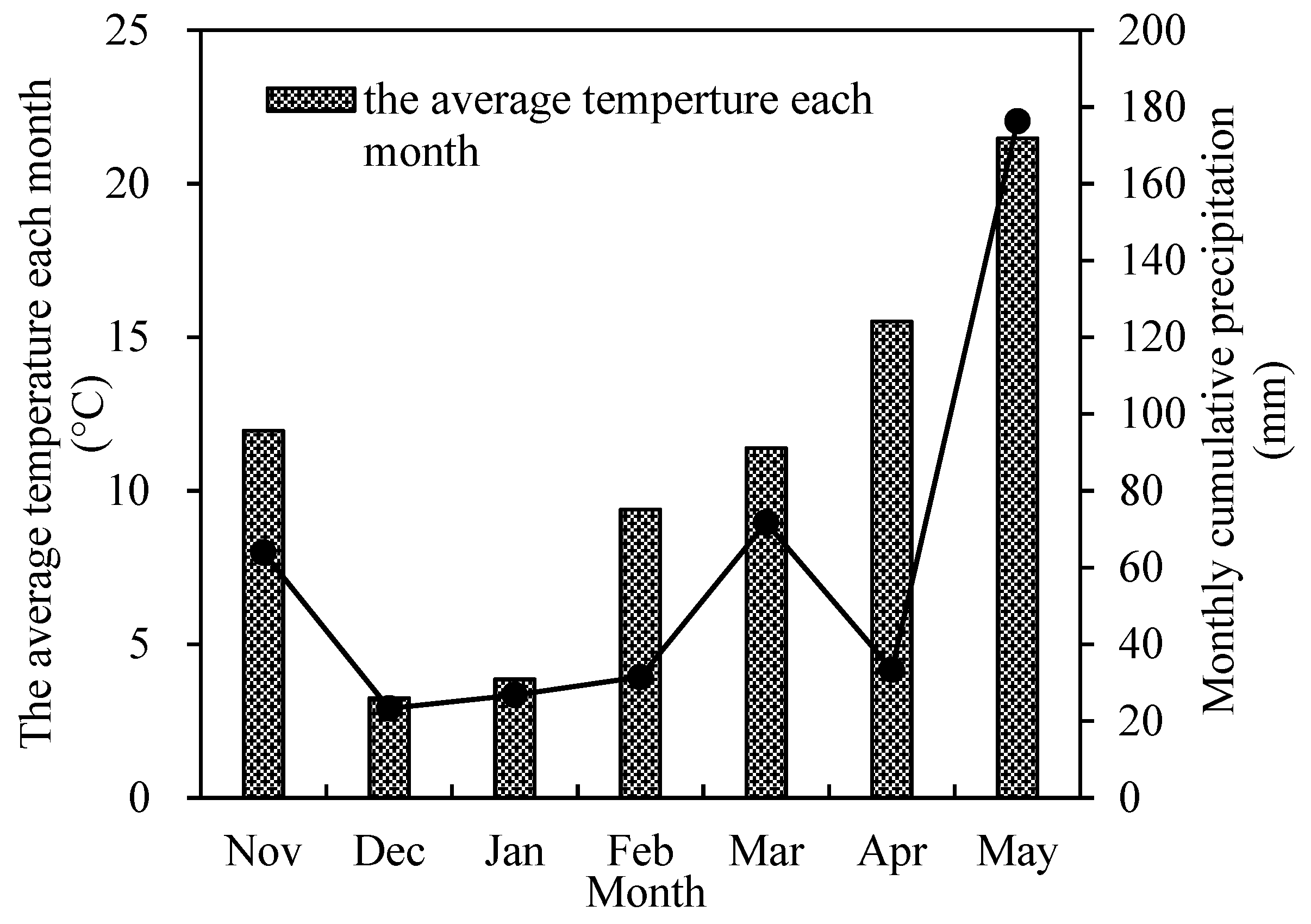
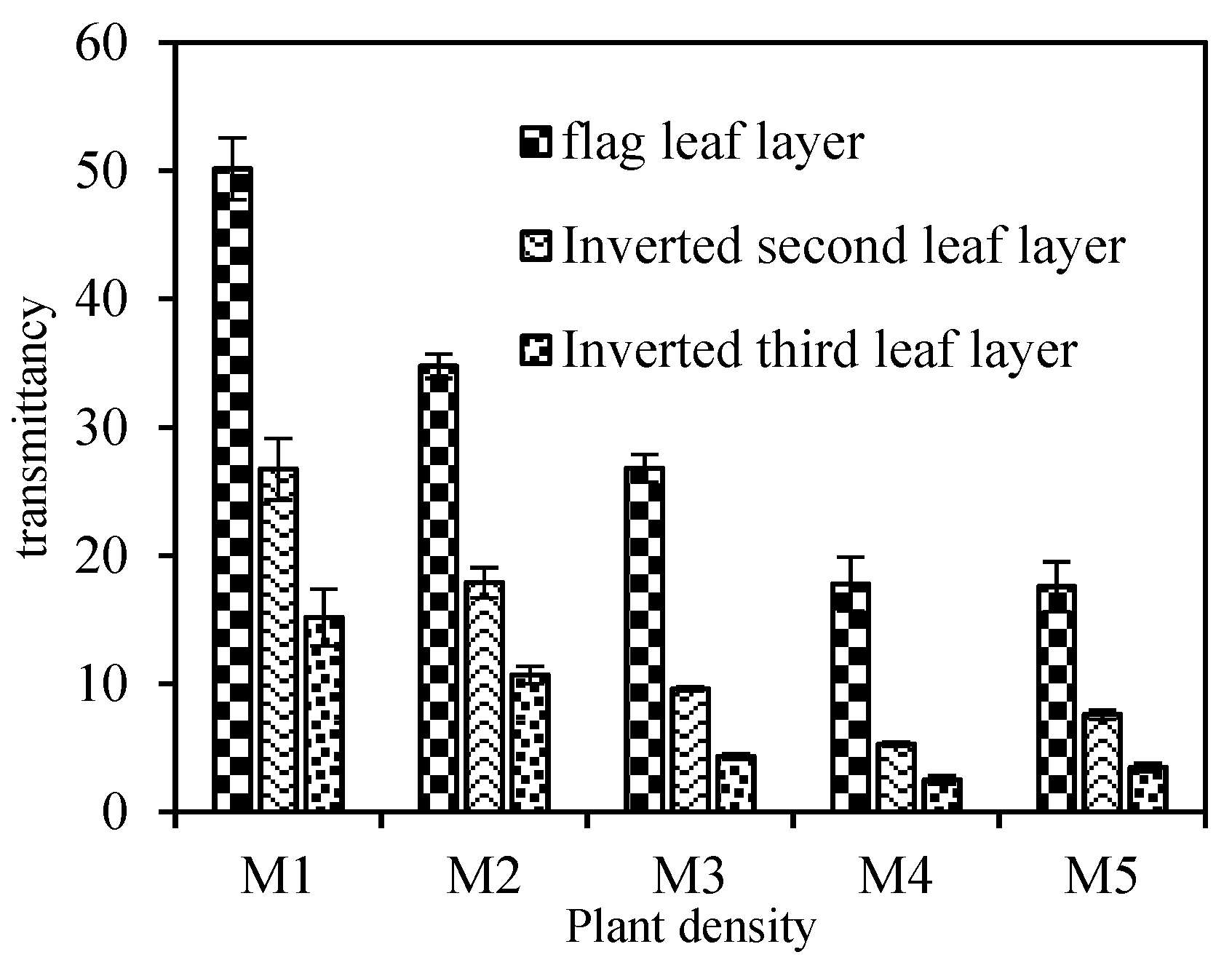
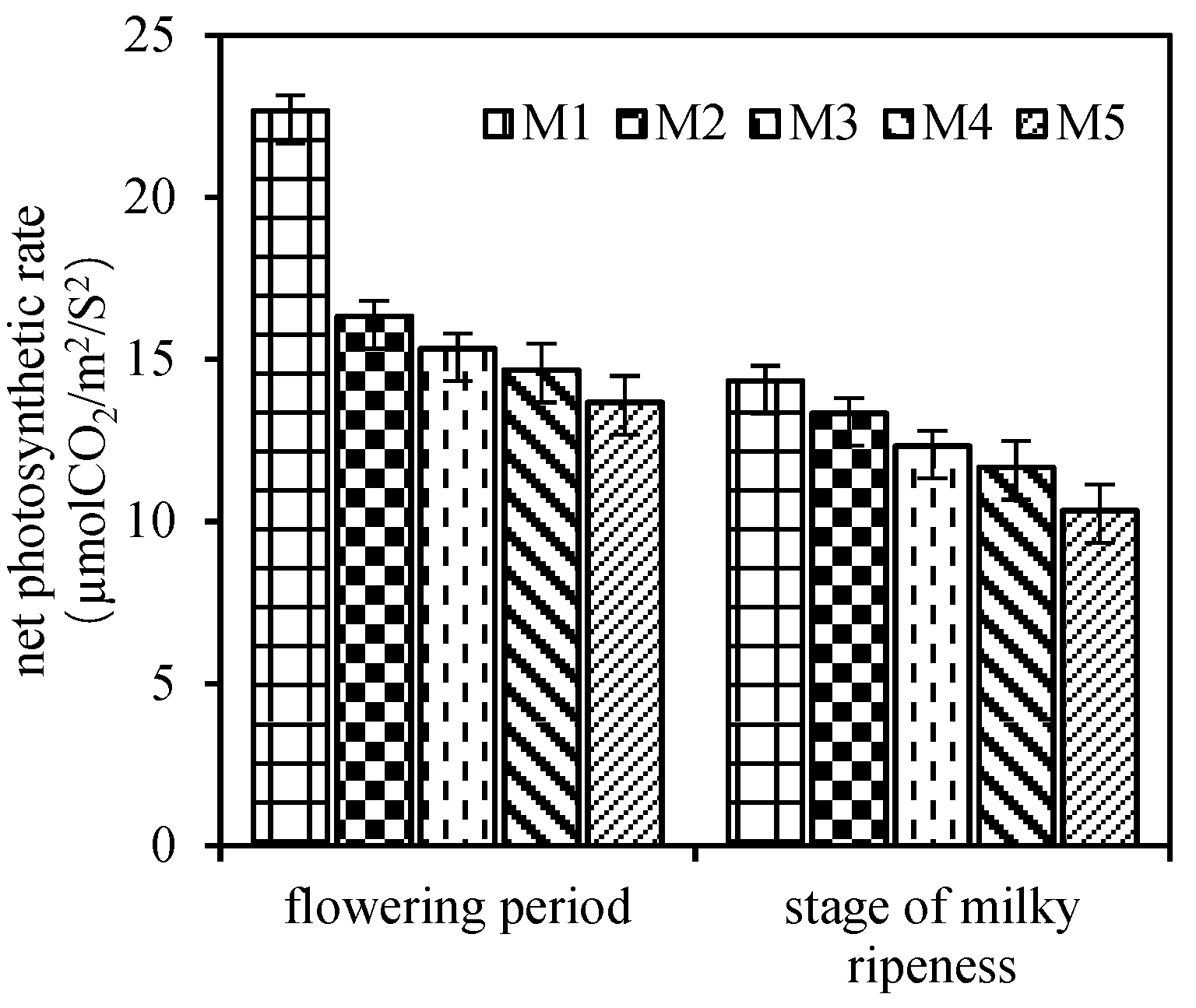
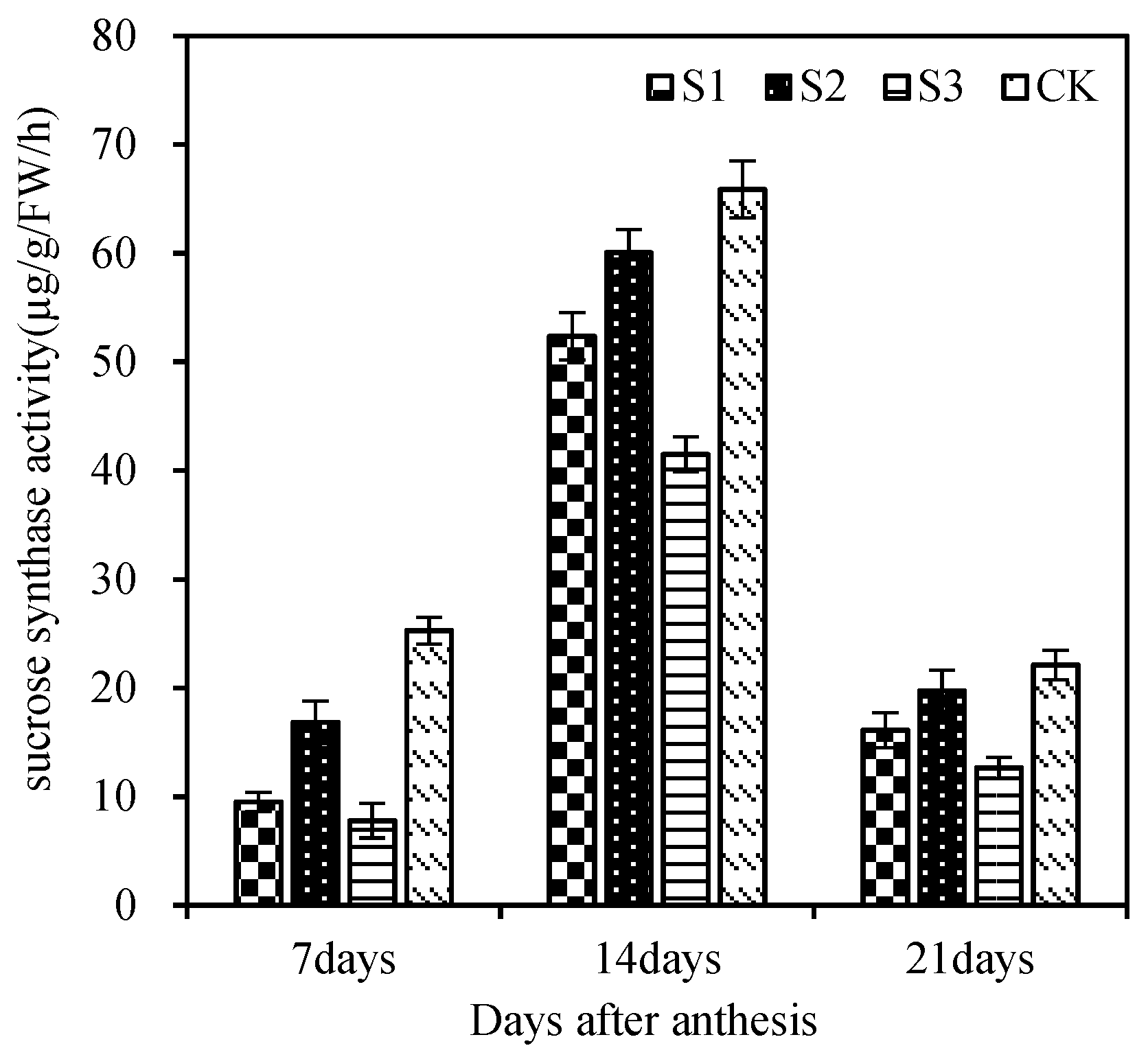
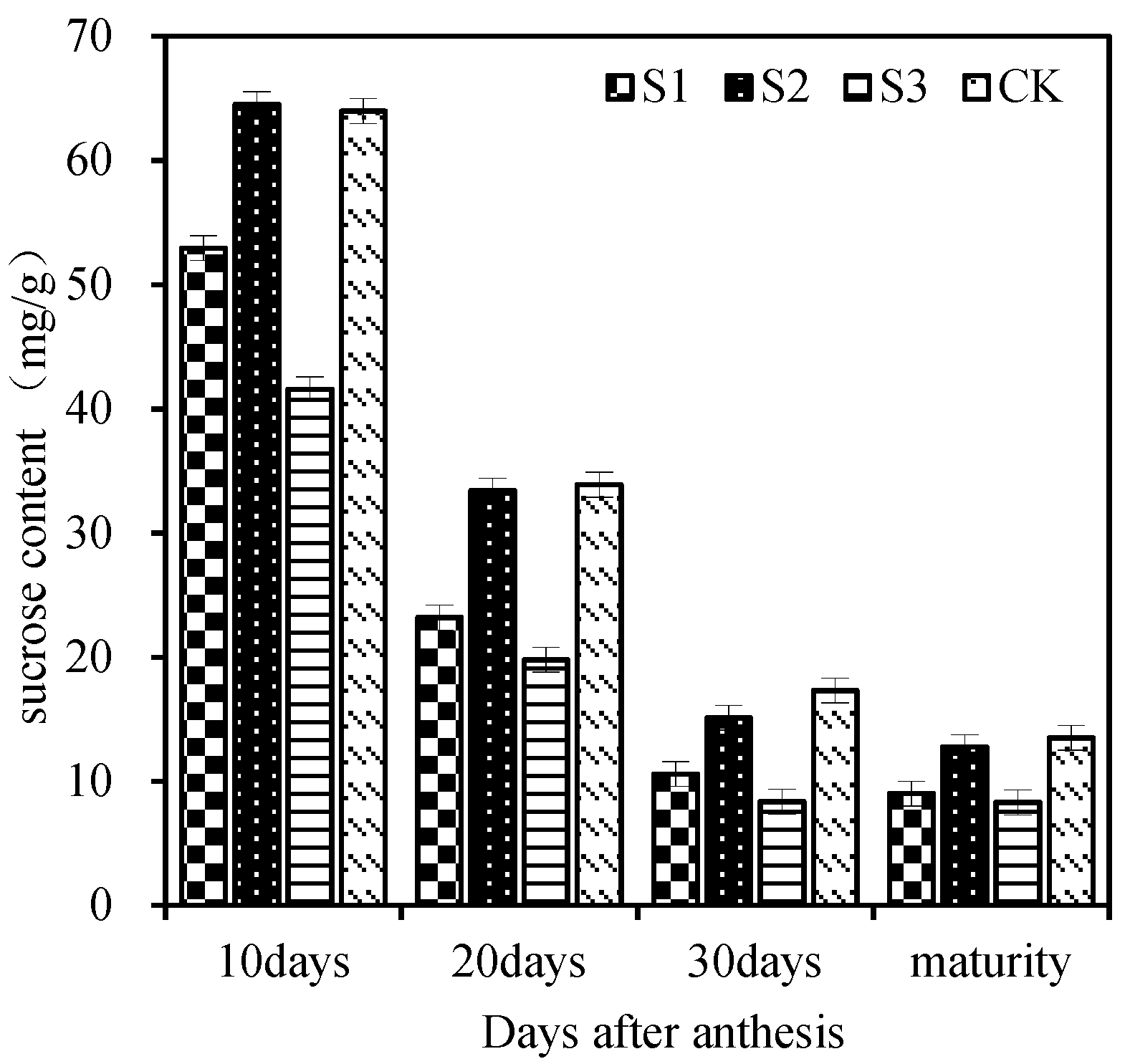
| Treatment | Corresponding Processing Number |
|---|---|
| 75 × 104/hm2 | M1 |
| 150 × 104/hm2 | M2 |
| 225 × 104/hm2 | M3 |
| 300 × 104/hm2 | M4 |
| 375 × 104/hm2 | M5 |
| Treatment | Corresponding Processing Number |
|---|---|
| Cut three leaves | S1 |
| Cut the remaining leaves except for the upper three leaves | S2 |
| Cut whole leaves | S3 |
| Normal plants | CK |
| Treatment | Effective Spike Number (104/hm2) | Kernel Number Per Spike | Thousand-Grain Weight (g) | Grain Yield (kg/hm2) |
|---|---|---|---|---|
| M1 | 365.67 c | 47.36 a | 44.2 b | 7015.17 b |
| M2 | 393.33 bc | 47.33 a | 45.08 a | 7649.67 a |
| M3 | 419.67 abc | 46.14 a | 42.35 c | 7546.93 a |
| M4 | 440.67 ab | 40.86 b | 42.43 c | 7012.63 b |
| M5 | 462.67 a | 39.84 b | 41.57 c | 7047.87 b |
| Treatment | Fruiting Spikelet Number Per Spike | Total Number of Spikelet Per Spike | Stem-Tiller Rate of Spike (%) |
|---|---|---|---|
| M1 | 17.96 c | 19.71 d | 58.51 a |
| M2 | 18.64 a | 20.27 a | 42.39 b |
| M3 | 18.22 b | 20.05 b | 39.16 c |
| M4 | 17.65 d | 19.88 c | 34.60 e |
| M5 | 16.96 e | 18.69 e | 36.45 d |
| Treatment | Over-Wintering Stage | Jointing Stage | Booting Stage | Flowering Stage | Milk-Ripe Stage |
|---|---|---|---|---|---|
| M1 | 0.15 d | 2.32 e | 4.88 c | 4.65 b | 3.20 c |
| M2 | 0.28 c | 3.01 d | 5.81 b | 4.77 a | 3.62 a |
| M3 | 0.50 b | 3.91 c | 5.84 b | 4.57 b | 3.46 b |
| M4 | 0.54 b | 4.23 b | 6.00 ab | 4.14 c | 3.25 c |
| M5 | 0.69 a | 4.57 a | 6.46 a | 4.02 c | 3.16 c |
| Treatment | Emergence-Overwintering (kg/hm2) | Overwintering-Jointing (kg/hm2) | Jointing-Booting (kg/hm2) | Booting-Flowering (kg/hm2) | Flowering-Ripening (kg/hm2) |
|---|---|---|---|---|---|
| M1 | 111.50 e | 1452.48 e | 4111.37 c | 3604.69 c | 3909.57 c |
| M2 | 213.15 d | 1864.59 d | 5192.51 a | 3924.25 b | 4907.87 a |
| M3 | 356.66 c | 2278.66 c | 4308.24 b | 3971.81 a | 4496.47 b |
| M4 | 364.20 b | 2375.47 a | 3812.5 d | 3427.50 e | 3708.66 e |
| M5 | 564.01 a | 2330.16 b | 3589.44 e | 3458.00 d | 3896.54 d |
| Treatment | N Uptake of 15N Labeled Urea (g/Plant) | N Accumulation (g/Plant) | 15N-Labeled Urea Nitrogen Utilization Rate (%) | ||||||
|---|---|---|---|---|---|---|---|---|---|
| Stem | Leaf | Spike | Stem | Leaf | Spike | Stem | Leaf | Spike | |
| M2 | 0.1 a | 0.04 a | 1.04 a | 0.38 a | 0.16 a | 3.64 a | 5.75 a | 2.23 a | 57.63 a |
| M4 | 0.05 b | 0.02 b | 0.6 b | 0.18 b | 0.09 b | 2.3 b | 2.64 b | 1.11 b | 32.99 b |
| Treatment | Stem (mg/pot) | Leaf (mg/pot) | Spike (mg/pot) | Total Accumulation (mg/pot) |
|---|---|---|---|---|
| S1 | 12.32 d | 2.02 d | 184.35 c | 198.69 c |
| S2 | 52.21 bc | 14.73 b | 388.9 a | 455.84 a |
| S3 | 19.41 d | / | 205.02 c | 224.44 c |
| CK | 39.92 c | 9.34 c | 379.61 a | 428.87 a |
| Treatment | Stem (%) | Leaf (%) | Spike (%) |
|---|---|---|---|
| S1 | 6.21 d | 1.02 d | 92.77 a |
| S2 | 11.46 c | 3.23 c | 85.31 b |
| S3 | 8.65 cd | / | 91.35 a |
| CK | 9.34 cd | 2.21 cd | 88.45 ab |
Disclaimer/Publisher’s Note: The statements, opinions and data contained in all publications are solely those of the individual author(s) and contributor(s) and not of MDPI and/or the editor(s). MDPI and/or the editor(s) disclaim responsibility for any injury to people or property resulting from any ideas, methods, instructions or products referred to in the content. |
© 2022 by the authors. Licensee MDPI, Basel, Switzerland. This article is an open access article distributed under the terms and conditions of the Creative Commons Attribution (CC BY) license (https://creativecommons.org/licenses/by/4.0/).
Share and Cite
Wei, J.; Yu, Q.; Ding, J.; Li, C.; Zhu, X.; Guo, W.; Zhu, M. Physiological and Agronomic Mechanisms Involved in ‘Source–Sink’ Relationship in the High-Yield Population of Weak-Gluten Wheat. Agronomy 2023, 13, 91. https://doi.org/10.3390/agronomy13010091
Wei J, Yu Q, Ding J, Li C, Zhu X, Guo W, Zhu M. Physiological and Agronomic Mechanisms Involved in ‘Source–Sink’ Relationship in the High-Yield Population of Weak-Gluten Wheat. Agronomy. 2023; 13(1):91. https://doi.org/10.3390/agronomy13010091
Chicago/Turabian StyleWei, Jingyu, Qi Yu, Jinfeng Ding, Chunyan Li, Xinkai Zhu, Wenshan Guo, and Min Zhu. 2023. "Physiological and Agronomic Mechanisms Involved in ‘Source–Sink’ Relationship in the High-Yield Population of Weak-Gluten Wheat" Agronomy 13, no. 1: 91. https://doi.org/10.3390/agronomy13010091
APA StyleWei, J., Yu, Q., Ding, J., Li, C., Zhu, X., Guo, W., & Zhu, M. (2023). Physiological and Agronomic Mechanisms Involved in ‘Source–Sink’ Relationship in the High-Yield Population of Weak-Gluten Wheat. Agronomy, 13(1), 91. https://doi.org/10.3390/agronomy13010091










